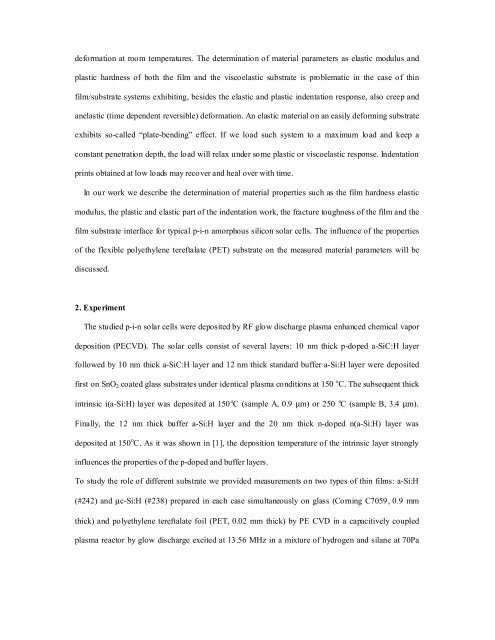Elsevier Editorial System(tm) for Journal of Non-Crystalline ... - Amper
Elsevier Editorial System(tm) for Journal of Non-Crystalline ... - Amper
Elsevier Editorial System(tm) for Journal of Non-Crystalline ... - Amper
Create successful ePaper yourself
Turn your PDF publications into a flip-book with our unique Google optimized e-Paper software.
de<strong>for</strong>mation at room temperatures. The determination <strong>of</strong> material parameters as elastic modulus and<br />
plastic hardness <strong>of</strong> both the film and the viscoelastic substrate is problematic in the case <strong>of</strong> thin<br />
film/substrate systems exhibiting, besides the elastic and plastic indentation response, also creep and<br />
anelastic (time dependent reversible) de<strong>for</strong>mation. An elastic material on an easily de<strong>for</strong>ming substrate<br />
exhibits so-called “plate-bending” effect. If we load such system to a maximum load and keep a<br />
constant penetration depth, the load will relax under some plastic or viscoelastic response. Indentation<br />
prints obtained at low loads may recover and heal over with time.<br />
In our work we describe the determination <strong>of</strong> material properties such as the film hardness elastic<br />
modulus, the plastic and elastic part <strong>of</strong> the indentation work, the fracture toughness <strong>of</strong> the film and the<br />
film substrate interface <strong>for</strong> typical p-i-n amorphous silicon solar cells. The influence <strong>of</strong> the properties<br />
<strong>of</strong> the flexible polyethylene tereftalate (PET) substrate on the measured material parameters will be<br />
discussed.<br />
2. Experiment<br />
The studied p-i-n solar cells were deposited by RF glow discharge plasma enhanced chemical vapor<br />
deposition (PECVD). The solar cells consist <strong>of</strong> several layers: 10 nm thick p-doped a-SiC:H layer<br />
followed by 10 nm thick a-SiC:H layer and 12 nm thick standard buffer a-Si:H layer were deposited<br />
first on SnO2 coated glass substrates under identical plasma conditions at 150 o C. The subsequent thick<br />
intrinsic i(a-Si:H) layer was deposited at 150 o C (sample A, 0.9 µm) or 250 o C (sample B, 3.4 µm).<br />
Finally, the 12 nm thick buffer a-Si:H layer and the 20 nm thick n-doped n(a-Si:H) layer was<br />
deposited at 150 o C. As it was shown in [1], the deposition temperature <strong>of</strong> the intrinsic layer strongly<br />
influences the properties <strong>of</strong> the p-doped and buffer layers.<br />
To study the role <strong>of</strong> different substrate we provided measurements on two types <strong>of</strong> thin films: a-Si:H<br />
(#242) and µc-Si:H (#238) prepared in each case simultaneously on glass (Corning C7059, 0.9 mm<br />
thick) and polyethylene tereftalate foil (PET, 0.02 mm thick) by PE CVD in a capacitively coupled<br />
plasma reactor by glow discharge excited at 13.56 MHz in a mixture <strong>of</strong> hydrogen and silane at 70Pa
















